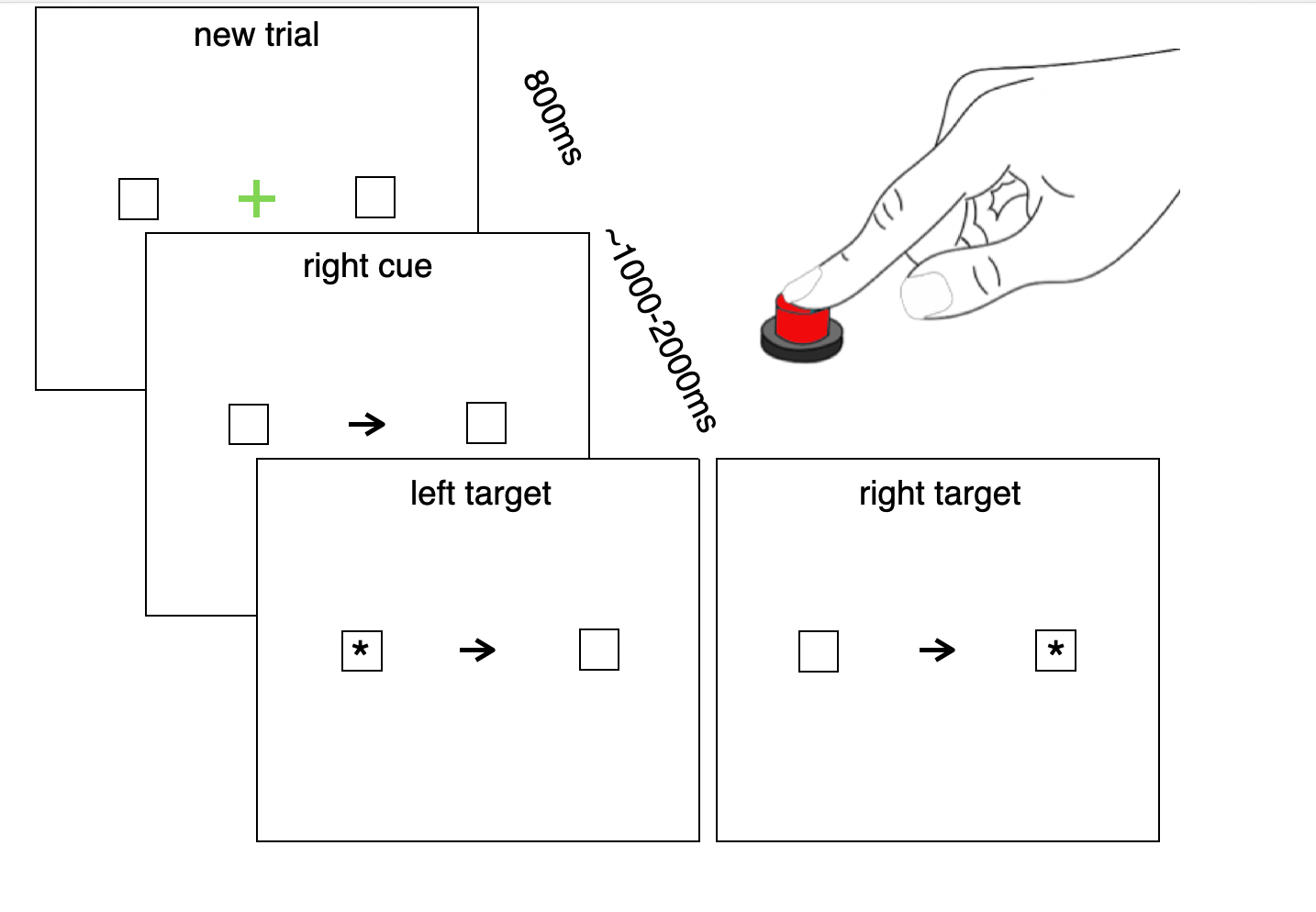Visuospatial attention

Figure: Example of the The Posner orienting task modified from [1]. The arrow (i.e. the cue) is presented for 2360ms. The asterisk (i.e. the target) is presented for 300ms.
Visuospatial attention has been assessed along several dimensions, including visual search (i.e., cancellations tasks) and reaction time.
Star cancellation is a paper and pencil visual search test originally proposed in and part of the Behavioral Inattention Test [2]. The patient has to circle all stars printed on a large A4 piece of paper. Stars are mixed with letters and words that the patient should not circle.
Mesulam Unstructured Symbol Cancellation Test is a paper and pencil visual search test where symbolic targets are mixed with symbolic distractors [3].
The Posner orienting task is a detection paradigm initially designed by [1]. The paradigm is computerised and consists of two square frames (1° size) placed on the left and the right of a central fixation (at 3.3° of eccentricity). Trials start when the central fixation turns from red to green. After 800ms, an arrow points left or right. 1000 to 2000ms later, an asterisk appears in one of the two square frames, 75% of the time at the location indicated by the cue (valid trials). In the other 25% the asterisk appears in the opposite location (invalid trials). Patients are required to press a button when an asterisk appears on the screen with their ipsilesional hand. A pause of 2360ms separates each trial. Each patient performs 120 trials divided into one practice block and two test blocks.
| Score | Info |
|---|---|
| bit_coc | Center of cancellation (BIT) |
| bit_ltot_miss | Left misses (BIT) |
| bit_rtot_miss | Right misses (BIT) |
| bit_tot_miss | Total misses (BIT) |
| mes_coc | Center of cancellation (Mes-USCT) |
| mes_l_miss | Left misses (Mes-USCT) |
| mes_r_miss | Right misses (Mes-USCT) |
| mes_tot_miss | Total misses (Mes-USCT) |
| pos_acc_avg | Accuracy average (Posner) |
| pos_acc_disengage | Accuracy disengagement (Posner) |
| pos_acc_li | Accuracy left invalid (Posner) |
| pos_acc_lv | Accuracy left valid (Posner) |
| pos_acc_ri | Accuracy right invalid (Posner) |
| pos_acc_rv | Accuracy right valid (Posner) |
| pos_acc_validity | Accuracy validity (Posner) |
| pos_acc_vf | Accuracy visual effect (Posner) |
| pos_rt_avg | Reaction time average (Posner) |
| pos_rt_disengage | Reaction time disengagement (Posner) |
| pos_rt_li | Reaction time left invalid (Posner) |
| pos_rt_lv | Reaction time left valid (Posner) |
| pos_rt_ri | Reaction time right invalid (Posner) |
| pos_rt_rv | Reaction time right valid (Posner) |
| pos_rt_validity | Reaction time validity (Posner) |
| pos_rt_vf | Reaction time visual effect (Posner) |
| pos_sub_avg | Subbing average (Posner) |
| pos_sub_disengage | Subbing disengagement (Posner) |
| pos_sub_li | Subbing left invalid (Posner) |
| pos_sub_lv | Subbing left valid (Posner) |
| pos_sub_ri | Subbing right invalid (Posner) |
| pos_sub_rv | Subbing right valid (Posner) |
| pos_sub_validity | Subbing validity (Posner) |
| pos_sub_vf | Subbing visual effect (Posner) |
BIT= Behavioural Inattention Test, Mes-USCT=Mesulam Unstructured Symbol Cancellation Test
1. Posner, M.I. and Y. Cohen, Components of visual orienting. Attention and performance X: Control of language processes, 1984. 32: p. 531-556.
2. Wilson, B., J.F. Cockburn, and P. Halligan, Development of a behavioral test of visuospatial neglect. Arch Phys Med Rehabil., 1987. 68(2): p. 98-102.
3. Mesulam, M.M., Principle of Behavioural Neurology: Tests of Directed Attention and Memory (Contemporary Neurology Series). 1985: F.A. Davis Company.